Answered step by step
Verified Expert Solution
Question
1 Approved Answer
LING 372 Final exam LING 372 - FINAL EXAM Due Friday, April 28 by 10:15 AM Name: Student ID: Instructions: Enter all your answers
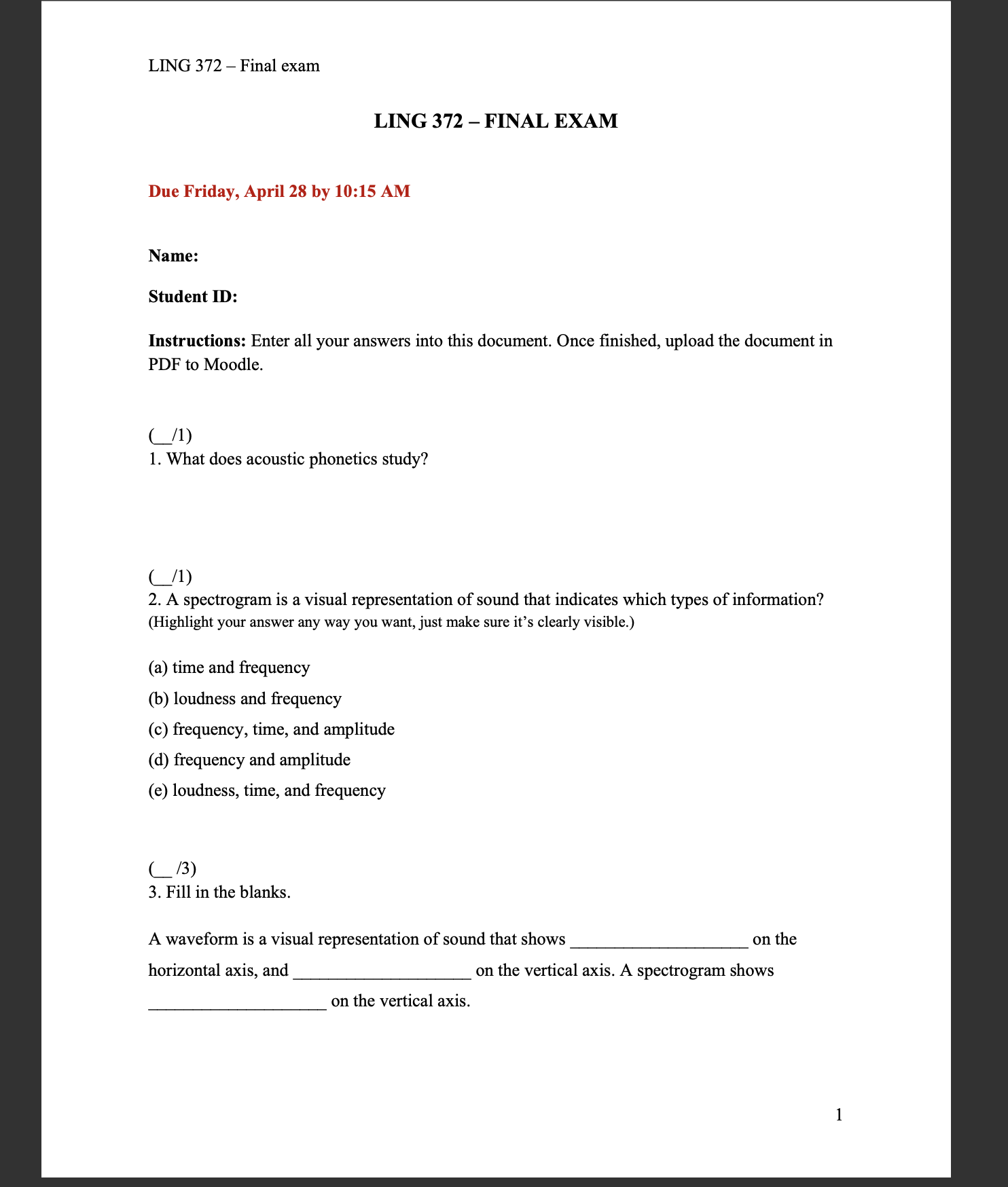
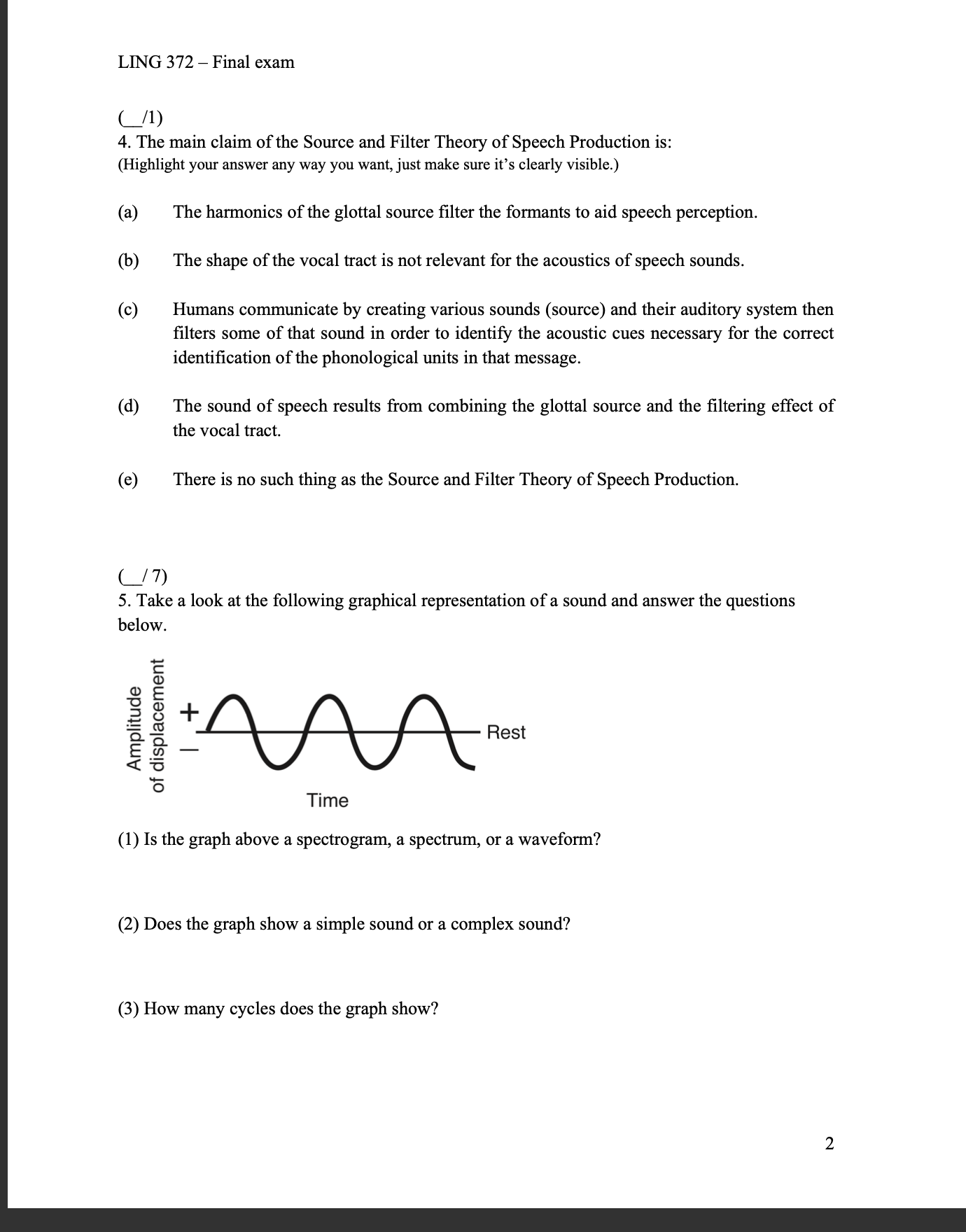
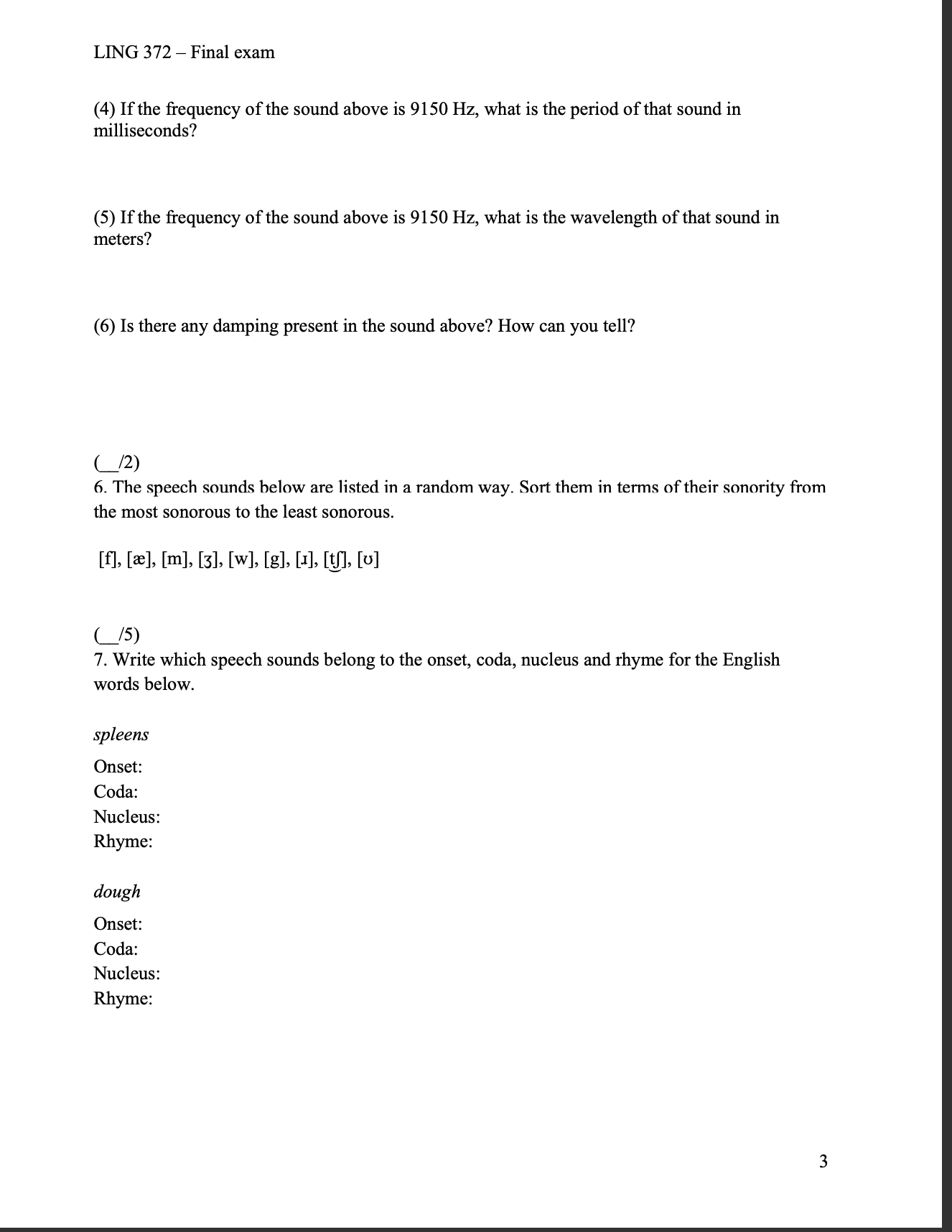

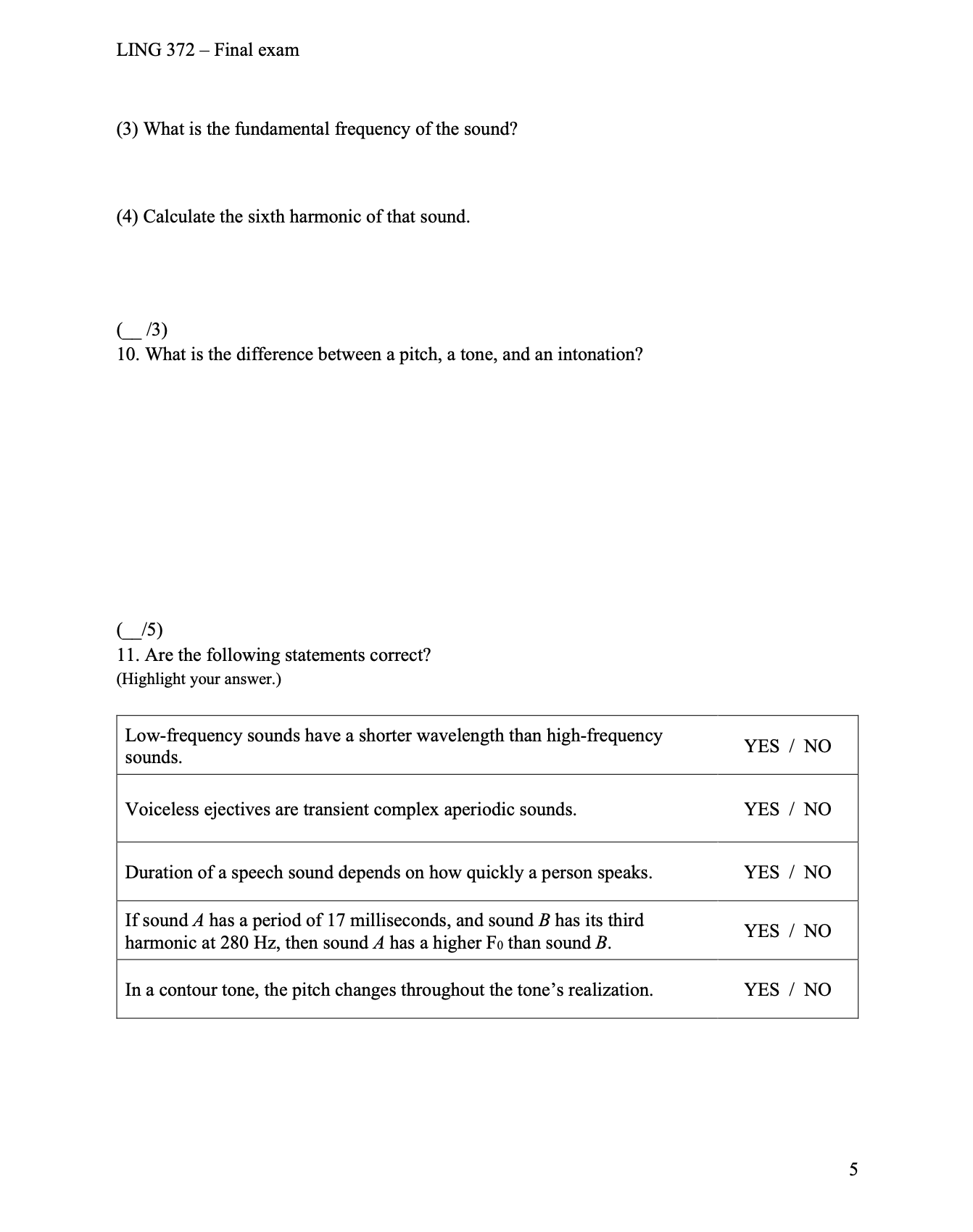


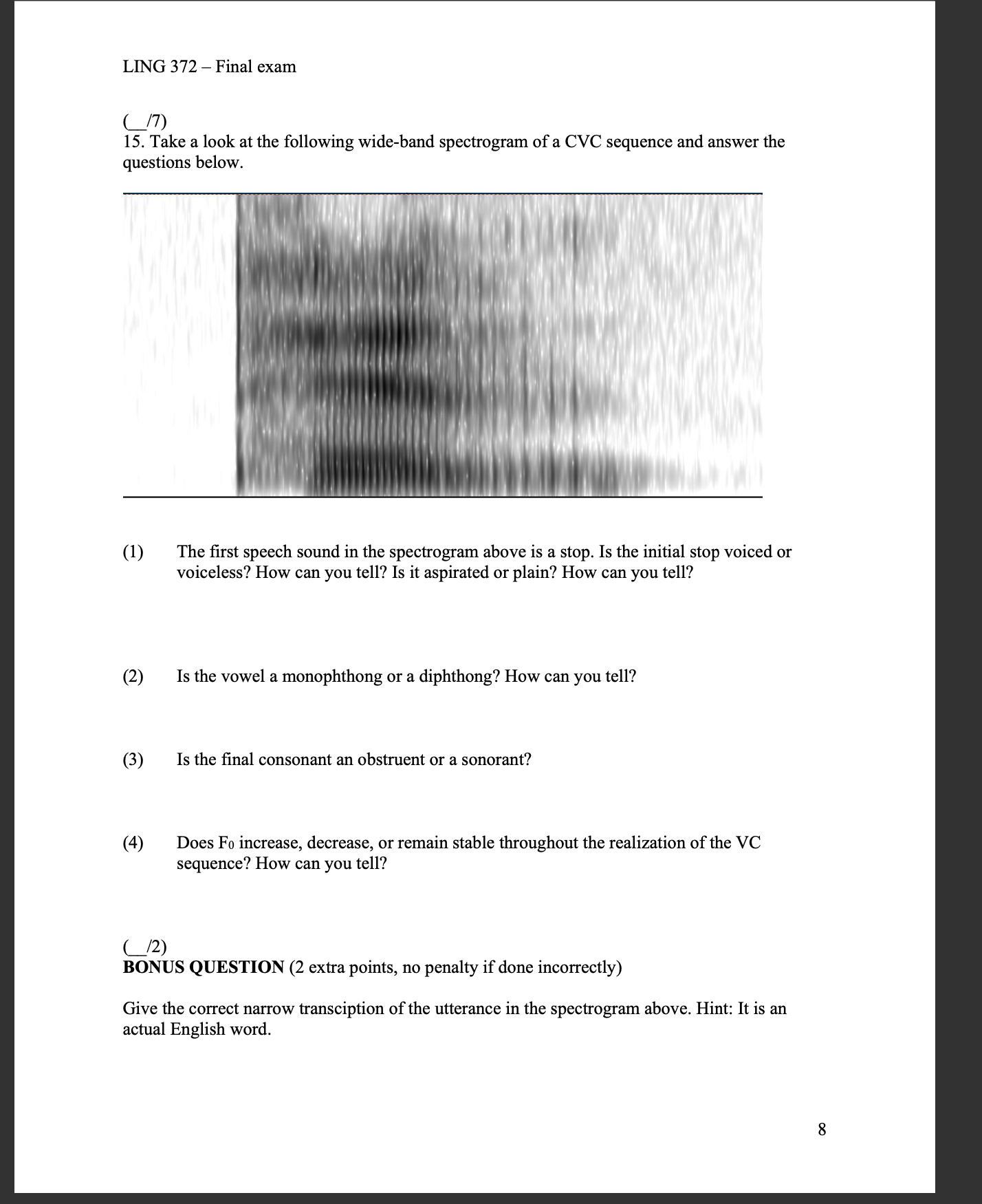
LING 372 Final exam LING 372 - FINAL EXAM Due Friday, April 28 by 10:15 AM Name: Student ID: Instructions: Enter all your answers into this document. Once finished, upload the document in PDF to Moodle. ( ___/1) 1. What does acoustic phonetics study? (/1) 2. A spectrogram is a visual representation of sound that indicates which types of information? (Highlight your answer any way you want, just make sure it's clearly visible.) (a) time and frequency (b) loudness and frequency (c) frequency, time, and amplitude (d) frequency and amplitude (e) loudness, time, and frequency ( /3) 3. Fill in the blanks. A waveform is a visual representation of sound that shows on the horizontal axis, and on the vertical axis. A spectrogram shows on the vertical axis. LING 372 Final exam (/1) 4. The main claim of the Source and Filter Theory of Speech Production is: (Highlight your answer any way you want, just make sure it's clearly visible.) The harmonics of the glottal source filter the formants to aid speech perception. (a) (b) The shape of the vocal tract is not relevant for the acoustics of speech sounds. (c) (d) Humans communicate by creating various sounds (source) and their auditory system then filters some of that sound in order to identify the acoustic cues necessary for the correct identification of the phonological units in that message. The sound of speech results from combining the glottal source and the filtering effect of the vocal tract. (e) There is no such thing as the Source and Filter Theory of Speech Production. (/7) 5. Take a look at the following graphical representation of a sound and answer the questions below. Amplitude Rest Time (1) Is the graph above a spectrogram, a spectrum, or a waveform? (2) Does the graph show a simple sound or a complex sound? (3) How many cycles does the graph show? 2 LING 372 Final exam (4) If the frequency of the sound above is 9150 Hz, what is the period of that sound in milliseconds? (5) If the frequency of the sound above is 9150 Hz, what is the wavelength of that sound in meters? (6) Is there any damping present in the sound above? How can you tell? (/2) 6. The speech sounds below are listed in a random way. Sort them in terms of their sonority from the most sonorous to the least sonorous. [f], [], [m], [3], [w], [g], [1], [t], [] (/5) 7. Write which speech sounds belong to the onset, coda, nucleus and rhyme for the English words below. spleens Onset: Coda: Nucleus: Rhyme: dough Onset: Coda: Nucleus: Rhyme: 3 LING 372 - Final exam bicycle First syllable Second syllable Third syllable Onset: Onset: Onset: Coda: Coda: Coda: Nucleus: Nucleus: Nucleus: Rhyme: Rhyme: Rhyme: (/2) 8. Explain how the behavior of F1 and F2 varies with changes in vowel height, frontness, and lip rounding. (/5) 9. Take a look at the following graphical representation of a sound and answer the questions below. (A stands for amplitude.) A. 100 300 500 Hz (1) Is the graph above a spectrogram, a spectrum, or a waveform? (2) Does the graph show a simple sound or a complex sound? How can you tell? 4 LING 372 Final exam (3) What is the fundamental frequency of the sound? (4) Calculate the sixth harmonic of that sound. ( /3) 10. What is the difference between a pitch, a tone, and an intonation? (/5) 11. Are the following statements correct? (Highlight your answer.) Low-frequency sounds have a shorter wavelength than high-frequency sounds. Voiceless ejectives are transient complex aperiodic sounds. Duration of a speech sound depends on how quickly a person speaks. If sound A has a period of 17 milliseconds, and sound B has its third harmonic at 280 Hz, then sound A has a higher Fo than sound B. In a contour tone, the pitch changes throughout the tone's realization. YES / NO YES / NO YES/NO YES / NO YES / NO 5 LING 372 Final exam (/2) 12. Take a look at the spectrogram of a VCV sequence and answer the questions below. (1) Is the first vowel [i], [], [], [u], or [a]? (2) Is the intervocalic consonant [w], [j], [1], or [1]? (/3) 13. To which of the forms listed below does the following spectrogram correspond? (Highlight your answer.) (a) [fv] (b) [fov] (c) [vf] (d) [vof] (e) [sez] (f) [soz] (g) [zes] (h) [zos] 6 LING 372 - Final exam (/3) 14. To which of the forms listed below does the following spectrogram correspond? (Highlight your answer.) (a) [api] (b) [ipa] (c) [abi] (d) [iba] (e) [ati] (f) [ita] (g) [adi] (h) [ida] 7 LING 372 - Final exam (/7) 15. Take a look at the following wide-band spectrogram of a CVC sequence and answer the questions below. (1) The first speech sound in the spectrogram above is a stop. Is the initial stop voiced or voiceless? How can you tell? Is it aspirated or plain? How can you tell? (2) Is the vowel a monophthong or a diphthong? How can you tell? (3) Is the final consonant an obstruent or a sonorant? (4) Does Fo increase, decrease, or remain stable throughout the realization of the VC sequence? How can you tell? (/2) BONUS QUESTION (2 extra points, no penalty if done incorrectly) Give the correct narrow transciption of the utterance in the spectrogram above. Hint: It is an actual English word. 00 8
Step by Step Solution
There are 3 Steps involved in it
Step: 1

Get Instant Access to Expert-Tailored Solutions
See step-by-step solutions with expert insights and AI powered tools for academic success
Step: 2

Step: 3

Ace Your Homework with AI
Get the answers you need in no time with our AI-driven, step-by-step assistance
Get Started


